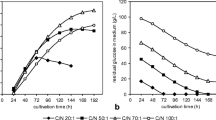Abstract
We present a novel light-dependent metabolism of an aromatic compound (trans-cinnamate) that is assimilatory rather than dissimilatory. Light-dependent assimilation of trans-cinnamate was observed by both growing and resting cells of Rhodobacter sphaeroides OU5. Trans-cinnamate assimilation could be correlated with simultaneous formation of both phenylalanine and tyrosine at near-stoichiometric ratios. Trans-cinnamate assimilation was promoted by carbon source and electron donors, such as glucose, pyruvate, or α-ketoglutarate, whereas malate, succinate, fumarate, and acetate were inhibitory.



Similar content being viewed by others
Literature Cited
Biebl H, Pfennig N (1981) Isolation of members of the family Rhodospirillaceae. In: Starr MP, Stolp H, Truper HG, Balows A, Schegel HG (eds) The prokaryotes, vol 1. New York, NY: Springer-Verlag, pp 167–273
Harwood CS, Gibson J (1988) Anaerobic and aerobic metabolism of diverse aromatic compounds by the photosynthetic bacterium Rhodopseudomonas palustris. Appl Environ Microbiol 54:712–717
Kyndt JA, Meyer TE, Cusanovish MA, Van Beeumen JJ (2002) Characterization of a bacterial tyrosine ammonia lyase, a biosynthetic enzyme for the photoactive yellow protein. FEBS Lett 512:240–244
Madigan MT, Gest H (1988) Selective enrichment and isolation of Rhodopseudomonas palustris using trans-cinnamic acid as sole carbon source. FEMS Microbiol Ecol 53:53–58
Miseta A, Csutora P, Sipos K, Wheatley DN (1996) Phenylalanine utilization for protein synthesis in beta-phenylpyruvic acid treated Escherichia coli cells. Microbios 87:123–133
Sasikala Ch, Ramana Ch V (1995) Biodegradation and metabolism of unusual carbon compounds by anoxygenic phototrophic bacteria. Adv Microbial Physiol 39:339–377
Sasikala Ch, Ramana Ch V, Raghuveer Rao P (1994) Nitrogen fixation by Rhodopseudomonas palustris OU11 with aromatic compounds as carbon source/electron donors. FEMS Microbiol Lett 122:75–78
Xiang L, Moore BS (2005) Biochemical characterization of a prokaryotic phenylalanine ammonia lyase. J Bacteriol 187:4286–4289
Acknowledgments
Council of Scientific and Industrial Research, Government of India, is acknowledged for financial support.
Author information
Authors and Affiliations
Corresponding author
Rights and permissions
About this article
Cite this article
Usha, P., Sasikala, C. & Ramana, C.V. Light-Dependent Assimilation of trans-Cinnamate by Rhodobacter sphaeroides OU5. Curr Microbiol 54, 410–413 (2007). https://doi.org/10.1007/s00284-006-0440-8
Received:
Accepted:
Published:
Issue Date:
DOI: https://doi.org/10.1007/s00284-006-0440-8




